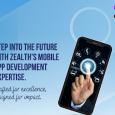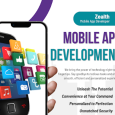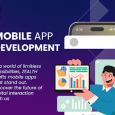The Ultimate Guide to Developing a B2B Mobile App: Tips and Best Practices
In today’s digital age, having a mobile app for your B2B business is crucial to stay competitive and meet the needs of your customers. A well-designed mobile app can help you streamline your operations, improve customer engagement, and increase revenue. However, developing a mobile app can be a complex process, requiring careful planning and execution. In this blog post, we’ll discuss the key steps involved in developing a B2B mobile app, along with tips and best practices to help you succeed.
Stage 1: Planning and Research
Before you start developing your B2B mobile app, it’s important to do your research and plan out your strategy. This involves identifying your target audience, defining your app’s purpose and features, and choosing the right technology stack. Some important steps to consider are:
Define your target audience
To better understand your target audience, it’s important to identify their needs and challenges. What features would they find most valuable in a mobile app? By understanding your audience’s needs, you can design an app that meets their expectations and delivers value.
Define your app’s purpose
What specific issue or challenge does your application address for your target audience? Is it a tool for managing orders and inventory, or a platform for accessing customer support? Clearly defining your app’s purpose will help guide your design and development decisions.
Choose your technology stack
Will you develop your app natively for iOS and Android, or use a cross-platform framework like React Native? What backend infrastructure will you need to support your app’s functionality? Choosing the right technology stack is critical to ensuring that your app performs well and meets your business needs.
Stage 2: Design and Prototyping
Once you have a clear plan in place, it’s time to start designing your app’s user interface (UI) and user experience (UX). This stage involves creating wireframes, mockups, and prototypes to test and refine your design. Following are some recommended best practices:
Keep it simple
B2B mobile apps should be easy to use and navigate, with clear calls to action and intuitive workflows. Avoid cluttering your app with unnecessary features or complex design elements.
Use a consistent design language
Choose a design language that aligns with your brand and use it consistently throughout your app. This includes typography, colour schemes, and iconography.
Test early and often
Use prototyping tools to test your design with real users and gather feedback. This will help you identify any usability issues or areas for improvement before you start development.
Stage 3: Development
Once your design is finalized, it’s time to start development. This stage involves building your app’s frontend and backend, integrating APIs and third-party services, and testing your app for bugs and performance issues. Consider these useful tips for your reference:
Use agile development methodologies
Agile methodologies like Scrum or Kanban can help you develop your app in an iterative, incremental way, allowing you to quickly respond to changing requirements or feedback.
Prioritize security and data privacy
B2B mobile apps often deal with sensitive customer data, so it’s important to ensure that your app is secure and complies with relevant data privacy regulations.
Leverage cloud computing
Cloud computing platforms like AWS or Azure can help you scale your app’s backend infrastructure as needed, and provide reliable hosting and storage for your app’s data.
Stage 4: Testing and Quality Assurance
Once your app is developed, it’s important to thoroughly test it to ensure that it functions correctly and meets your business needs. This involves testing for bugs, performance issues, and usability problems. Here are some suggested best practices to adopt:
Use automated testing tools
Automated testing tools like Appium or Selenium can help you test your app across multiple devices and platforms, and identify any issues before you release your app to users.
Conduct user acceptance testing
User acceptance testing (UAT) involves testing your app with real users to ensure that it meets their expectations and delivers value. This approach can assist you in detecting potential usability problems or opportunities for enhancements.
Ensure accessibility
B2B mobile apps should be accessible to all users, including those with disabilities. Ensure that your app meets accessibility standards and guidelines, such as the Web Content Accessibility Guidelines (WCAG).
Stage 5: Deployment
Once your app has been tested and is ready for release, it’s time to deploy it to the app stores or distribute it to your customers. Some recommended practices to follow include:
Follow app store guidelines
If you’re releasing your app on the app stores, ensure that your app meets the guidelines and requirements set by Apple or Google. This includes complying with relevant policies and regulations.
Distribute your app securely
If you’re distributing your app directly to your customers, ensure that you have secure distribution methods in place, such as using an enterprise mobile app management (EMAM) solution.
Plan for updates and maintenance
After your app is deployed, it will require ongoing maintenance and updates to ensure that it continues to function correctly and meets your business needs. Plan for these updates in advance and communicate any changes to your users.
Stage 6: Post-Deployment
After your app is deployed, it’s important to track its performance and gather feedback from users to identify areas for improvement. Some recommended practices to follow include:
Monitor app analytics
Use app analytics tools to track your app’s performance, such as user engagement, retention, and conversion rates. Employing this technique can assist you in identifying areas that require improvement and making decisions based on data.
Gather user feedback
Encourage users to provide feedback on your app’s functionality, usability, and overall experience. Use this feedback to pinpoint any potential issues or areas that require improvement.
Continuously improve your app
Use agile methodologies to continuously improve your app over time, responding to changing user needs and business requirements.
Conclusion
In conclusion, developing a B2B mobile app requires careful planning, design, development, testing, and deployment. By following these best practices and tips, you can ensure that your app meets the needs of your customers and delivers value to your business. Remember to prioritize security, usability, and accessibility, and to continuously gather feedback and make improvements over time. With the right strategy and execution, your B2B mobile app can become a valuable tool for driving business growth and success.




